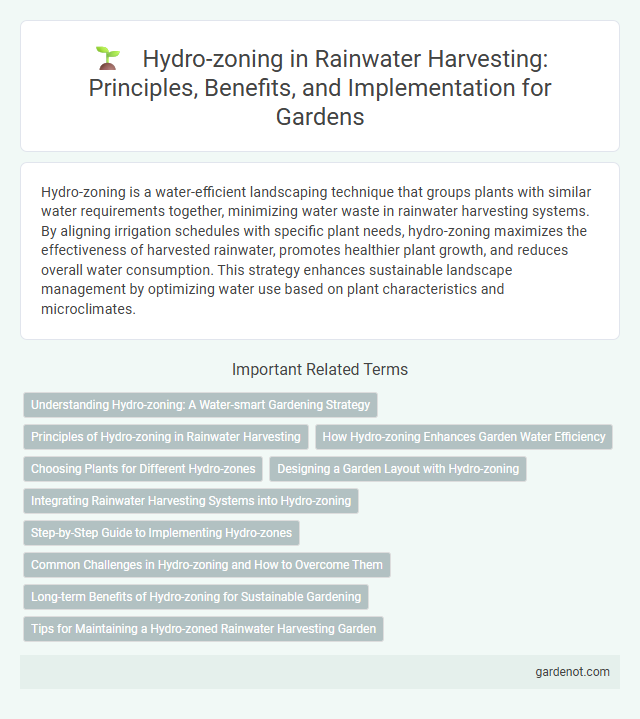Hydro-zoning is a water-efficient landscaping technique that groups plants with similar water requirements together, minimizing water waste in rainwater harvesting systems. By aligning irrigation schedules with specific plant needs, hydro-zoning maximizes the effectiveness of harvested rainwater, promotes healthier plant growth, and reduces overall water consumption. This strategy enhances sustainable landscape management by optimizing water use based on plant characteristics and microclimates.
Understanding Hydro-zoning: A Water-smart Gardening Strategy
Hydro-zoning divides a garden into distinct zones based on water needs to optimize rainwater harvesting efficiency. Grouping plants with similar moisture requirements minimizes water waste and promotes healthy growth, reducing irrigation demands. Implementing hydro-zoning in landscape design enhances water conservation and supports sustainable water management practices.
Principles of Hydro-zoning in Rainwater Harvesting
Hydro-zoning in rainwater harvesting involves grouping plants with similar water needs together to optimize irrigation efficiency and minimize water waste. This approach ensures targeted water application, enhances soil moisture retention, and reduces runoff by matching plant water demands with captured rainwater availability. Implementing hydro-zoning principles promotes sustainable landscape management and improves overall system performance in rainwater harvesting projects.
How Hydro-zoning Enhances Garden Water Efficiency
Hydro-zoning enhances garden water efficiency by grouping plants with similar water needs, which minimizes water waste through targeted irrigation. This method reduces runoff and evaporation by delivering precise amounts of water directly to each zone, optimizing water usage. Implementing hydro-zoning in rainwater harvesting systems maximizes resource conservation while maintaining healthy plant growth.
Choosing Plants for Different Hydro-zones
Selecting plants for different hydro-zones enhances the efficiency of rainwater harvesting by matching vegetation to soil moisture levels. Drought-tolerant species thrive in dry hydro-zones, while moisture-loving plants are ideal for areas with frequent water accumulation. Proper plant selection reduces irrigation needs, supports local biodiversity, and promotes sustainable water management.
Designing a Garden Layout with Hydro-zoning
Hydro-zoning in garden design involves grouping plants with similar water requirements to optimize rainwater harvesting efficiency and reduce irrigation needs. By creating distinct zones based on plant water needs, such as drought-tolerant xeriscape areas and moisture-loving sections, water distribution becomes more precise and sustainable. This strategic garden layout minimizes water waste, enhances soil health, and supports ecosystem resilience.
Integrating Rainwater Harvesting Systems into Hydro-zoning
Hydro-zoning involves grouping plants with similar water requirements to optimize irrigation efficiency while integrating rainwater harvesting systems enhances this approach by utilizing captured rainwater for targeted watering zones. Implementing smart irrigation controls linked with rainwater storage ensures precise water delivery based on plant needs and rainfall patterns, reducing water waste and promoting sustainable landscape management. This synergy between hydro-zoning and rainwater harvesting supports peak water conservation efforts in urban and residential landscapes.
Step-by-Step Guide to Implementing Hydro-zones
Hydro-zoning involves grouping plants with similar water needs to optimize rainwater harvesting and irrigation efficiency. Begin by analyzing soil types and plant water requirements within your landscape, then map out distinct zones for high, medium, and low water-use species. Install separate irrigation systems for each zone to ensure precise water delivery, reduce waste, and promote sustainable water management.
Common Challenges in Hydro-zoning and How to Overcome Them
Common challenges in hydro-zoning include inaccurate soil and plant water requirement assessments, leading to inefficient irrigation schedules and water wastage. Overcoming these issues requires detailed soil moisture mapping and selecting drought-tolerant native plants to match specific hydrozones. Implementing smart irrigation controllers with real-time sensors enhances water use efficiency by adapting watering schedules based on weather and soil conditions.
Long-term Benefits of Hydro-zoning for Sustainable Gardening
Hydro-zoning improves water efficiency by grouping plants with similar water needs, reducing water waste and promoting healthier plant growth. This method supports sustainable gardening by conserving water resources over time, lowering irrigation costs, and enhancing soil quality. Implementing hydro-zoning fosters resilient landscapes that adapt to climate variability and contribute to long-term environmental sustainability.
Tips for Maintaining a Hydro-zoned Rainwater Harvesting Garden
Effective maintenance of a hydro-zoned rainwater harvesting garden involves regularly assessing plant water needs to ensure each zone receives appropriate irrigation, preventing overuse or drought stress. Use mulch to retain soil moisture and reduce evaporation, particularly in low-water zones. Routinely inspect rainwater collection and distribution systems for leaks or blockages to maintain efficient water delivery tailored to each hydro zone.
Hydro-zoning Infographic

 gardenot.com
gardenot.com